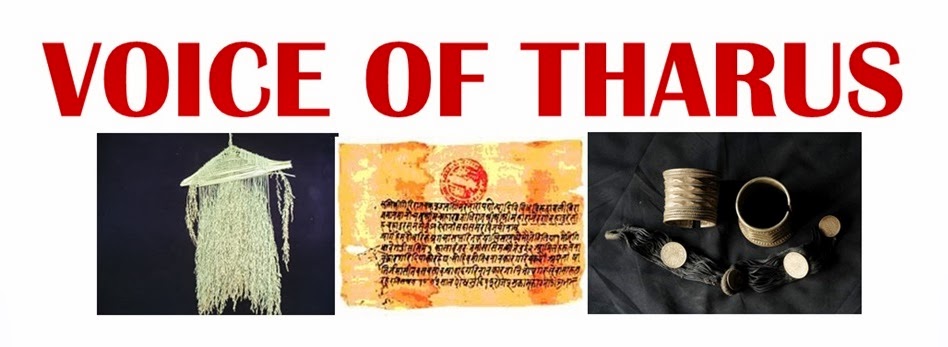 |
| Artists performing Tharu dance at Bhada Homestay (c) Tharuwan.com |
When I first stepped in the village, it was sparkling clean. Each house was designated a number starting from one and the identical houses had well-kept garden plots in their front. The rooms were well-kept, neat and tidy, handicraft items nailed to the walls, few hanging down from the rooftop and the mud rice-barns lined to the walls.
The food served was delicious, the home-made alcohol intoxicating – a little bit sour but nice to taste, the snails cooked in linseed paste was greasy but really tasty.
Now let me list down the reasons why you should visit a Tharu homestay, one by one.
Experience the clean and tranquil environment
Tharu villages are generally far from the main roads. They like to live in peace. Once you are in a Tharu village, you will no more hear the honking of horns or experience the fast-paced city life. It’s a peaceful feeling especially when all return from fields in the evening. All house-owners sweep the surrounding as they return from work, tend to their cattle and fowls and lit fires in the cow-sheds to drive away the mosquitoes and burn the wastes collected from sweeping.
Get closer to the nature
All Tharu villages have plenty of trees in the surrounding. Mango orchards, bamboo plantations, ponds and gardens with fruit trees are essential parts of a Tharu village. From early morning till the evening, you will get to hear the chirping of birds, mooing of cows and crowing of roosters that are soothing to the ears.
If you inform them in advance, they will also arrange for a bullock-cart to pick you up from the road-head. Riding on the cart, adjusting to the jolts on the way, you will feel like returning to medieval ages. And to keep you in company will be the smell of wild flowers and fresh tilled soil.
Explore and learn about Tharu culture first hand
In a homestay, you get to live with a family. You learn from their daily activities – how they do their daily chores, what type of clothes they wear, what type of food they cook and the list goes on. If you land there during major festivals like Maghi and Hori, you will be more than surprised and envy the rich culture.
Tharus are labelled as honest and humble people. Get close to them and they will share their experiences. All, with a wide smile.
Learn from the ages-old designs
Be it the small clay figurines made by the Tharus during their festivals or the motifs inspired by nature on their walls, you will be inspired. The unique jewelry designs and the tattoos inked on their arms, legs and chests, they all will leave you mesmerized.
Have a look at the tilling equipment, the mud cook-stove, the mud rice barns, the thatched roofs, the intricately woven handicraft items and the fishing equipment. Don’t tell me you won’t be inspired.
Savour the delicious food
If you inform the hosts that you will have their traditional dinner, they will arrange all – snail curry, mouse chutney, sidhara (dried fish), sticky rice, fish curry, bagiya and a plethora of other traditional dishes along with nigar, the home-brewed alcohol.
The Tharu homestays to visit
Dalla in Bardia district
The Tharu homestay at Dalla of Bardia is the first of its kind. WWF coerced and supported the community to establish the homestay. Now it’s a win-win situation for both the community and conservation.
In Dalla, the local people, besides restoring forests, also started restoring wildlife habitat by restoring grasslands and building water holes. As a result, wild animals can be seen in the vicinity including the rhinos and the elusive tiger.
Bhada in Kailali district
Learning from the Dalla experience, the Tharu leaders established homestay at Bhada village of Kailali district. Located 17 kilometres east of Dhangadhi, the homestay has eighteen houses. You can experience the bullock cart ride from the Chaumala of East-West Highway to the village.
If you know Nepali, click the link to find the details or you can contact Mr Laxmi Narayan at 9749028004 as mentioned in the site Tharuwan.com.
Agyauli, Baghkhor (Amaltari) in Nawalparasi district
After crossing Kawasoti on the East-West Highway, you will come to a small town called Danda. The homestay is seven kilometres south from Danda. Twenty houses have been allocated for homestay and here you can go for a canoe ride in the Narayani River or an elephant ride in the buffer zone forest. You will surely get to see rhinos in the forest and in the evening you can enjoy the traditional Jhumara and lathi dances performed by local artists.
Inarbaruwa in Chitwan district
Tharu women have initiated a homestay in Inarbaruwa of Madi Baghauda village development committee of Chitwan district. Currently, they can cater to 25 tourists out of eight houses allocated for the purpose.
To reach the homestay, you will need to head southwards from Bharatpur. You can enjoy the Jhumra, Chhekra and Jhamta dances performed by local artists in the evening. Nearby are the religious places like Goddhak Baba, Someshwor Kalika temple and Baikuntha Lake.
Kunti in Surkhet district
If you walk two kilometres southward from Birendranagar in Surkhet, you will reach a beautiful Tharu village. Nearby is the famous Kakrebihar and you will experience the clean and tranquil environment. The villagers are planning to host tourists in each of their 20 houses.
Sishahaniya in Dang district
A model Tharu village is being turned into a homestay in Sishahaniya of Dang district.
